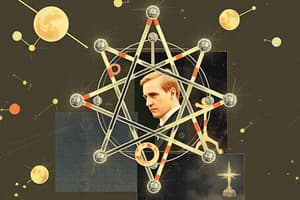Podcast
Questions and Answers
What defines the atomic number of an element?
What defines the atomic number of an element?
- Total number of protons and neutrons
- Number of protons in an atom (correct)
- Total mass of the atom
- Number of electrons orbiting the nucleus
Which type of bond is formed by the transfer of electrons?
Which type of bond is formed by the transfer of electrons?
- Metallic bond
- Covalent bond
- Ionic bond (correct)
- Hydrogen bond
What is the main characteristic of an exothermic reaction?
What is the main characteristic of an exothermic reaction?
- Releases heat to the surroundings (correct)
- Absorbs heat from the surroundings
- Decreases energy of the products
- Increases temperature of reactants
Which of the following is a characteristic of gases?
Which of the following is a characteristic of gases?
What happens during a decomposition reaction?
What happens during a decomposition reaction?
What does a pH value below 7 indicate?
What does a pH value below 7 indicate?
What is represented by the equilibrium constant K?
What is represented by the equilibrium constant K?
What does the mole concept define?
What does the mole concept define?
Study Notes
Basic Concepts of Chemistry
- Matter: Anything that has mass and occupies space; exists in solid, liquid, and gas states.
- Atoms: Basic units of matter; composed of protons, neutrons, and electrons.
- Protons: Positively charged particles in the nucleus.
- Neutrons: Neutral particles in the nucleus.
- Electrons: Negatively charged particles orbiting the nucleus.
Atomic Structure
- Atomic Number: Number of protons in an atom; defines the element.
- Mass Number: Total number of protons and neutrons in an atom.
- Isotopes: Atoms of the same element with different numbers of neutrons.
Periodic Table
- Organized by increasing atomic number.
- Groups (columns): Elements with similar properties.
- Periods (rows): Elements with the same number of electron shells.
Chemical Bonds
- Ionic Bonds: Formed through the transfer of electrons from one atom to another, creating charged ions.
- Covalent Bonds: Formed when two atoms share electrons.
- Metallic Bonds: Occur between metal atoms where electrons are shared in a "sea of electrons."
Chemical Reactions
- Reactants: Substances that undergo change during a reaction.
- Products: Substances formed as a result of a reaction.
- Types of Reactions:
- Synthesis: A + B → AB
- Decomposition: AB → A + B
- Single Replacement: A + BC → AC + B
- Double Replacement: AB + CD → AD + CB
- Combustion: Hydrocarbon + O2 → CO2 + H2O
States of Matter
- Solid: Definite shape and volume; particles are closely packed.
- Liquid: Definite volume but takes the shape of its container; particles are less closely packed.
- Gas: No definite shape or volume; particles are far apart and move freely.
Acids and Bases
- Acids: Substances that donate protons (H+) and have a pH below 7.
- Bases: Substances that accept protons and have a pH above 7.
- pH Scale: Measures acidity or basicity; ranges from 0 (strong acid) to 14 (strong base).
Thermodynamics in Chemistry
- Endothermic Reactions: Absorb heat from the surroundings (ΔH > 0).
- Exothermic Reactions: Release heat to the surroundings (ΔH < 0).
Stoichiometry
- Study of the quantitative relationships between reactants and products in a chemical reaction.
- Mole Concept: 1 mole = 6.022 × 10²³ particles (Avogadro's number).
Chemical Equilibrium
- State where the rate of the forward reaction equals the rate of the reverse reaction.
- Represented by the equilibrium constant (K).
Common Laboratory Techniques
- Filtration: Separates solids from liquids.
- Distillation: Separates mixtures based on different boiling points.
- Titration: Method to determine concentration by adding known amounts of a solution to react with a sample.
Key Definitions
- Electronegativity: Measure of an atom's ability to attract electrons in a bond.
- Catalyst: Substance that increases the rate of a chemical reaction without being consumed.
This summary covers fundamental concepts essential for understanding chemistry as a subject.
Basic Concepts of Chemistry
- Matter is anything that has mass and occupies space.
- Matter exists in three states: solid, liquid, and gas.
- Atoms are the basic units of matter, composed of protons, neutrons, and electrons.
- Protons are positively charged particles found in the nucleus.
- Neutrons are neutral particles also located in the nucleus.
- Electrons are negatively charged particles that orbit the nucleus.
Atomic Structure
- The atomic number represents the number of protons in an atom and defines the element.
- The mass number represents the total number of protons and neutrons in an atom.
- Isotopes are atoms of the same element with different numbers of neutrons.
Periodic Table
- The periodic table organizes elements by increasing atomic number.
- Groups (columns) contain elements with similar properties.
- Periods (rows) contain elements with the same number of electron shells.
Chemical Bonds
- Ionic bonds form when electrons are transferred from one atom to another, creating charged ions.
- Covalent bonds form when two atoms share electrons.
- Metallic bonds occur between metal atoms where electrons are shared in a "sea of electrons."
Chemical Reactions
- Reactants are substances that undergo change during a reaction.
- Products are substances formed as a result of a reaction.
- Synthesis: A + B → AB (combining two reactants to form a single product)
- Decomposition: AB → A + B (breaking down a compound into its constituent elements)
- Single Replacement: A + BC → AC + B (one element replaces another in a compound)
- Double Replacement: AB + CD → AD + CB (exchange of ions between two reactants)
- Combustion: Hydrocarbon + O2 → CO2 + H2O (burning a hydrocarbon in the presence of oxygen to produce carbon dioxide and water)
States of Matter
- Solids have a definite shape and volume; particles are closely packed.
- Liquids have a definite volume but take the shape of their container; particles are less closely packed.
- Gases have no definite shape or volume; particles are far apart and move freely.
Acids and Bases
- Acids donate protons (H+) and have a pH below 7.
- Bases accept protons and have a pH above 7.
- The pH scale measures acidity or basicity, ranging from 0 (strong acid) to 14 (strong base).
Thermodynamics in Chemistry
- Endothermic reactions absorb heat from the surroundings (ΔH > 0).
- Exothermic reactions release heat to the surroundings (ΔH < 0).
Stoichiometry
- Stoichiometry is the study of quantitative relationships between reactants and products in a chemical reaction.
- The mole concept: 1 mole = 6.022 × 10²³ particles (Avogadro's number).
Chemical Equilibrium
- Chemical equilibrium occurs when the rate of the forward reaction equals the rate of the reverse reaction.
- It is represented by the equilibrium constant (K).
Common Laboratory Techniques
- Filtration separates solids from liquids.
- Distillation separates mixtures based on different boiling points.
- Titration determines concentration by adding known amounts of a solution to react with a sample.
Key Definitions
- Electronegativity measures an atom's ability to attract electrons in a bond.
- A catalyst is a substance that increases the rate of a chemical reaction without being consumed.
Studying That Suits You
Use AI to generate personalized quizzes and flashcards to suit your learning preferences.
Description
Test your knowledge of foundational chemistry concepts, including matter, atomic structure, and the periodic table. This quiz covers essential topics such as atomic numbers, isotopes, and types of chemical bonds. Perfect for beginners or anyone looking to brush up on their chemistry skills.




